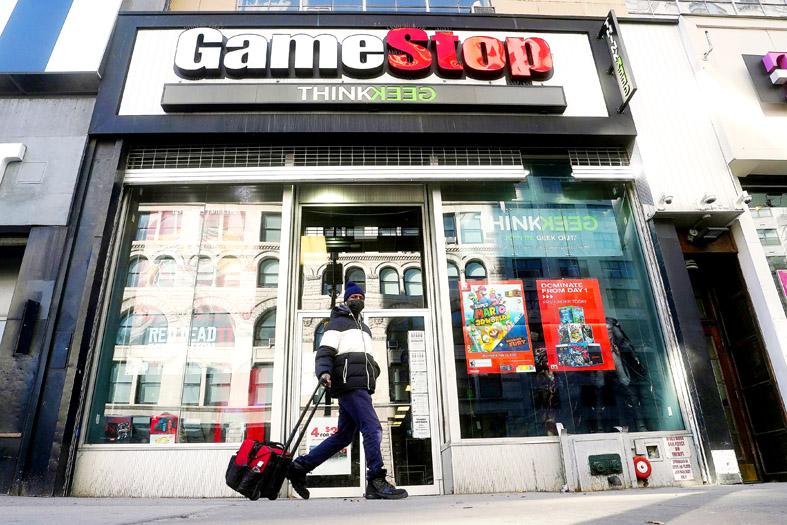The battle between retail investors and hedge funds burst seemingly out of nowhere last week, and many people have spent the weekend wondering how it would end.
The answer depends in part on two things: First, who will be first among the three group of actors — hedge funds shorting the handful of stocks, retail investors buying them and the intermediaries enabling both sides to trade — to surrender, especially if done through a disorderly unwinding of their book? Second, how will regulators and politicians react?
What has been colorfully, and not that inaccurately, labeled as the uprising of the little guys reflects the confluence of information platforms, data, and easy-to-use products and trading apps — all of which have been helping the more general phenomenon of democratizing finance.

Photo: Reuters
In addition to technology, big data and some relatively simple forms of artificial intelligence, the fuel also involved an accumulation of years of the everyday small investor feeling marginalized and disadvantaged by a finance establishment that appeared to have co-opted the US Federal Reserve and other agencies.
The catalyst — helped by the availability of cash and, in some cases, stimulus checks — came in the form of the discovery of a strategy in which the usual power brokers, led by the so-called smart money (the term historically used to refer to hedge funds), were significantly vulnerable. This strategy involved an ad hoc movement to buy the stocks of the most heavily shorted companies in the hope of triggering a short squeeze and forcing the bears to scramble and cover their positions.
It is a strategy that worked especially well in the case of GameStop Corp, where the accumulated shorts were equivalent to about 140 percent of the outstanding stock.
The hedge funds shorting were not the only ones exposed to what in markets is known as a pain trade. The intermediaries also found themselves under growing pressure, scrambling to safeguard their balance sheets and maintain prudential guidelines, being forced to cough up cash, draw on credit lines or both.
By the end of the week, all three actors were still in the game. Who will be knocked out first is far from straightforward.
Historically, small investors pushing up a handful of stocks would be at most risk of being picked off because of their limited individual capital, especially when squaring off against professional hedge funds. Under that outcome, the implications for the financial system would be relatively small notwithstanding the losses incurred by these investors.
Similar to a phenomenon that first came to global attention during the Arab Spring in the early 2010s, social media, and in this specific case Reddit, has enabled usually dispersed investors to become more of a strong collective force with a common purpose. To confront this new force and stay in the game, hedge funds have already been driven to raise cash to meet higher margin calls, with some also stopped out of their short positions.
This compelled a few of them to sell some of their long holdings, with the inclination to dispose of their most liquid ones. With that comes an element of market-wide contagion, the extent of which will depend on the strength of what, at least until now, has been a remarkable countervailing “buy the dip” conditioning.
Such damage to general asset prices, producing the worst week for the S&P 500 Index since October last year, pales in comparison to what would most likely happen if one of the intermediaries were forced into a disorderly deleveraging, whether it be a broker or central clearinghouse. If not handled well, this could have much broader effects, especially because the nonbank segment of the financial system has been in an unprecedented period of rapidly rising debt, leverage and risk-taking, aided and abetted by too many years of excessive policy reliance on experimental central bank measures, and regulatory and supervisory gaps.
Regardless of which of these scenarios plays out — and, to make things, even more interesting, they are not mutually exclusive — regulators and politicians can be expected to become involved in some capacity.
Harder to predict is what particular element they will focus on most; some can have competing effects on asset prices and market functioning. Among the targets could be small investor protection, investment suitability criteria, margin limits, possible collusion and price manipulation, and market structure.
What started out as a market curiosity — small investors taking on the Wall Street establishment using what had been periphery platforms too easily dismissed by the traditional market powers — has both broader origins and implications.
This is not just an epic David versus Goliath story that has attracted worldwide media attention. Potentially in play is the democratization of finance, tech-led disruptions to market hierarchy, the overall valuation of markets, regulatory and political responses, and the market structure itself.
Mohamed El-Erian is a Bloomberg Opinion columnist and president of Queens’ College, Cambridge; chief economic adviser at Allianz SE, the parent company of Pacific Investment Management Co, where he served as CEO and co-chief investment officer; and chair of Gramercy Fund Management.
This column does not necessarily reflect the opinion of the editorial board or Bloomberg LP and its owners.

TAKING STOCK: A Taiwanese cookware firm in Vietnam urged customers to assess inventory or place orders early so shipments can reach the US while tariffs are paused Taiwanese businesses in Vietnam are exploring alternatives after the White House imposed a 46 percent import duty on Vietnamese goods, following US President Donald Trump’s announcement of “reciprocal” tariffs on the US’ trading partners. Lo Shih-liang (羅世良), chairman of Brico Industry Co (裕茂工業), a Taiwanese company that manufactures cast iron cookware and stove components in Vietnam, said that more than 40 percent of his business was tied to the US market, describing the constant US policy shifts as an emotional roller coaster. “I work during the day and stay up all night watching the news. I’ve been following US news until 3am

UNCERTAINTY: Innolux activated a stringent supply chain management mechanism, as it did during the COVID-19 pandemic, to ensure optimal inventory levels for customers Flat-panel display makers AUO Corp (友達) and Innolux Corp (群創) yesterday said that about 12 to 20 percent of their display business is at risk of potential US tariffs and that they would relocate production or shipment destinations to mitigate the levies’ effects. US tariffs would have a direct impact of US$200 million on AUO’s revenue, company chairman Paul Peng (彭雙浪) told reporters on the sidelines of the Touch Taiwan trade show in Taipei yesterday. That would make up about 12 percent of the company’s overall revenue. To cope with the tariff uncertainty, AUO plans to allocate its production to manufacturing facilities in

COLLABORATION: Given Taiwan’s key position in global supply chains, the US firm is discussing strategies with local partners and clients to deal with global uncertainties Advanced Micro Devices Inc (AMD) yesterday said it is meeting with local ecosystem partners, including Taiwan Semiconductor Manufacturing Co (TSMC, 台積電), to discuss strategies, including long-term manufacturing, to navigate uncertainties such as US tariffs, as Taiwan occupies an important position in global supply chains. AMD chief executive officer Lisa Su (蘇姿丰) told reporters that Taiwan is an important part of the chip designer’s ecosystem and she is discussing with partners and customers in Taiwan to forge strong collaborations on different areas during this critical period. AMD has just become the first artificial-intelligence (AI) server chip customer of TSMC to utilize its advanced

Six years ago, LVMH’s billionaire CEO Bernard Arnault and US President Donald Trump cut the blue ribbon on a factory in rural Texas that would make designer handbags for Louis Vuitton, one of the world’s best-known luxury brands. However, since the high-profile opening, the factory has faced a host of problems limiting production, 11 former Louis Vuitton employees said. The site has consistently ranked among the worst-performing for Louis Vuitton globally, “significantly” underperforming other facilities, said three former Louis Vuitton workers and a senior industry source, who cited internal rankings shared with staff. The plant’s problems — which have not